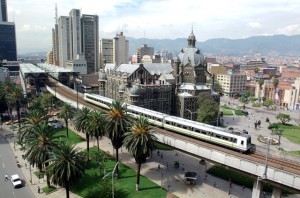By Daniela Cárdenas
Note from the author: Daniela Cárdenas, a sophomore studying Urban and Regional Studies in the College of Architecture, Art and Planning of Cornell University.
Social Urbanism and Metamorphosis of The Violent and Unstable City
I grew up in the beautiful city of Medellin, located in a valley of the Andes in Colombia and known for its serious social, economic and structural issues. Medellin has 3.5 million inhabitants and the second most important city in Colombia after Bogotá, the capital.

Medellin is the only city in Colombia with a Metro line, it runs along the river and crosses the entire city from north to south. This method of transportation is a symbol of improvement in the city that has been extremely beneficial for the population since it started operating in 1995. Image taken from: Colombia.travel (http://www.colombia.travel/en/international-tourist/multimedia/photo-gallery/medellin)

The MetroCable extension line started operating in 2004. It was initially built to serve one of the most dangerous and poor neighborhoods of the city in the northeast area. Image taken from Reflexiones Domingueras, http://reflexionesdomingueras.wordpress.com/tag/colombia

Medellin has 16 communes, and a river that crosses it from North to South. Image from Visiting Medellin: http://visitingmedellin.blogspot.com/2013/05/how-to-travel-in-medellin.html
When I was nine years old, a car bomb exploded in front of my apartment building. My entire home was destroyed within seconds; every single window had shattered and fallen onto the floor and the smell of burning plastic impregnated the air. That morning, I cried helplessly as I walked around my house and saw the damage. Hope came because thankfully nobody in my family was injured, and I had no reason to cry, I had to confront the situation.
Growing up in the Global South has shaped my life and my way of thinking about cities. Ever since I was a little child I was impressed with the idea of fearing the city, I could never walk the streets, take regular public transportation or even go out late at night. There was no trust or confidence amongst people, as violence had left its footprint in our hearts and minds, bombing our houses, kidnapping our relatives, murdering our children, and finally displacing us from our homeland.
All of this came from an impressed fear that drug trafficking and violence had left in my city, when back in the 80’s and the 90’s Medellin was one of the most violent cities of the world with a rate of 381 homicides per 100,000 inhabitants(Martin & Corrales , 2011, p.26)However, today I am proud to say that Medellin has improved its security situation by registering a rate of 47 homicides for every 100,000 inhabitants (Martin & Corrales , 2011). It is precisely this social problem that has delayed the development of my city, but throughout the years there have been many community and culturally based initiatives to improve the city with the use tools such as architecture and urban planning in order to fight crime.
On top of the violence and securities issues there are many geological and structural issues in Medellin. People constantly deal with floods and landslides that destroy homes, block roads and inhibit communication. While the damage is initially caused by nature, it is made significantly worse by mediocre construction and management. This problem affects a wide range of the population, starting from the marginalized communities with precarious settlements that are located in high-risk designated areas, up to the high-rise apartment buildings of the richest neighborhood in town: El Poblado. About a month ago, on October 12, a 22-story building in this neighborhood collapsed and killed 11 people (Wight, 2013). However the most vulnerable populations living in precarious settlements that they constructed themselves are the ones facing a greater risk in regards to geologically unstable homes.
The metamorphosis and transformation along with positive outlooks of processes that have been going on in my city, is what I want to address in this blog post. Precisely one the most important projects that has truly contributed to this transformation is the Northeastern Urban Integration Project, written and adapted in 2004 by a generation of architects and urban planners from my city that worked for the Urban Development Enterprise (Empresa de Desarrollo Urbano- EDU) . This group of people grew up with all these restrictions and limitations in the city and decided to transform Medellin with planning, architecture, design and public policies. One of them is Alejandro Echeverri, an architect and planner that was the director of the Northeastern Urban Integration Project, with whom I have had the opportunity to work with these two past summers.
In 2012, Medellin won a recognition award for being the most innovative city of the year. This award was given by CitiBank, The Wall Street Journal, and the Urban Land Institute to Medellin’s for its innovative way of addressing social and structural issues with a variety of tools including planning, architecture, culture and art. These mechanisms such as the northeastern integral plan, shows how Medellin is currently positioning itself in respect to the international community, and it shows the degree of improvement and development it has achieved in the past years.
Part II: The Northeastern Urban Integration Project
Works Cited
City of the year. (2012). Retrieved from http://online.wsj.com/ad/cityoftheyear
Kimmelman, M. (2012, May 18). A city rises, along with its hopes. The New York Times. Retrieved from http://www.nytimes.com/2012/05/20/arts/design/fighting-crime-with-architecture-in-medellin-colombia.html?_r=0
Martin, G., & Corrales , D. (2011). Medellin: Transformacion de una ciudad. Medellin: Multimpresos Ltda. Retrieved from http://www.eafit.edu.co/centros/urbam/Documents/libro.pdf
TEDx Medellin. (Producer). (2012, April 03). Urbanismo Social en Medellin, Alejandro Echeverri [Web Video]. Retrieved from http://tedxtalks.ted.com/video/TEDxMedelln-Alejandro-Echever-2
Wight, A. (2013, November 13). Colombia’s vp calls for bills freeze for medellin building collapse victims.Colombia Reports. Retrieved from http://colombiareports.co/colombian-vice-president-calls-bills-freeze-medellin-building-collapse-victims/
